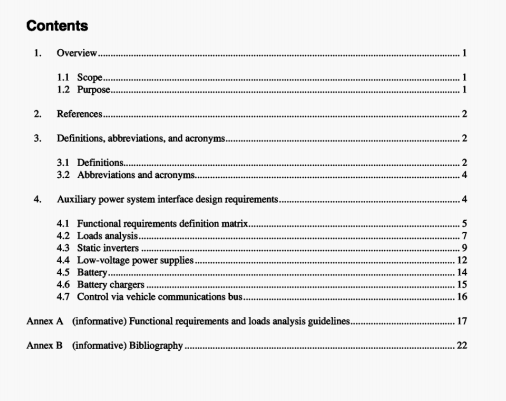IEEE Std 1476:2000 pdf free download.IEEE Standard for Passenger Train Auxiliary Power Systems lnterfaces.
a) Tabulation of constant power loads, such as public address/intercom, radio, propulsion control, etc., that derive their primary power from the LVPS but have their own regulated power supply included within the units. This type of load presents two different current draws. The first current draw is that which occurs while the LVPS is active and the second is an increased current draw when the load is switched to back-up battery wherein the voltage source (now the battery) is approximately 15% lower voltage. This results in a corresponding increased current draw. As the battery voltage continues to drop during discharge, the current draw increases. These are the worst-case loads on the battery.
b) Tabulation of resistive loads, such as incandescent lamps, relay logic, etc., that do not have internal regulated supplies. This type of load also presents two different current draws. The first current draw is that associated with the LVPS providing nominal output voltage, and the second is a reduced current draw when the load is switched to the back-up battery wherein the voltage is approximately 15% lower, thus resulting in a corresponding decreased current draw. As the battery voltage continues to drop during discharge, the current draw correspondingly decreases.
c) Tabulation of momentary/random loads, such as indicator lights, sanding magnet valves, etc., that are applied intermittently. These loads are treated on a duty cycle basis in sizing of the LVPS and the battery. These loads can effect the configuration of the LVPS and back-up battery employed as will be discussed later in 4.4.3.6 and 4.4.10. There are also random loads such as track brakes, side doors, and transient loads resulting from traversing rail gaps that can place significantly high demands for short periods of time on the battery and LVPS. The design of the battery, LVPS, and battery charging system must be coordinated such that these loads can be supplied by the battery without reducing its output voltage below the minimum system operating voltage. Care must also be taken to ensure that the charging system can replenish the battery during the normal operating runt of the vehicle. A peak load on the end of the load profile can significantly increase the battery capacity requirement.
d)Tabulation of constant current loads such as inverter/ballast driven lighting wherein the current draw remains constant, independent of voltage fluctuations of the LVPS/battery voltage.
e)The battery load current draw profile shall be compiled for the condition of a failed LVPS or other emergency conditions wherein the battery must provide power. The profile shall show current demand under various load-shed conditions versus time. This load profile is necessary to facilitate sizing of the battery.
IEEE Std 1476:2000 pdf free download
